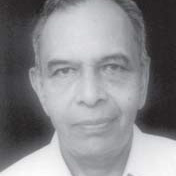N.S. Sandhu was born on 1 September 1932, and studied at Khalsa College, Amritsar. He joined the National Defence Academy and was commissioned in 3 Cavalry in 1953. He served in Gaza for a year on deputation to the United Nations Force, and joined his unit subsequently.
In the 1965 Indo-Pak War, Pakistan launched an offensive into Khemkaran and captured it on 8 September. 1 Armoured Division of Pakistan moved into Khemkaran on 8 September with a view to advance to Harike and Beas bridges. 3 Cavalry was part of the Force moved to block Pakistan’s armoured thrust. 3 Cavalry shadowed the outflanking move by Pakistan’s 4 Cavalry and attacked it from three directions. Several Pakistani tanks were destroyed. Sandhu was the C Squadron commander which destroyed 14 Pakistani tanks. He was awarded ‘Mention-in-Despatch’ for his courageous act.
He opted for transfer to Infantry and was the Commanding Officer of 10 Dogra Battalion in 1971. Dera Baba Nanak is a small town on River Ravi. It has a rail-cum-road double bridge across the Ravi and is of strategic importance, as it connects several Indian towns (Gurdaspur, Beas and Amritsar), with Sialkot and Narowal in Pakistan. In 1971, Pakistan occupied the eastern part of the bridge. It gave the enemy a choice of objectives which could unbalance our defences. Moreover, the Sikh community had a strong attachment to the place as Guru Nanak had spent the last eleven years of his life there. A historic Gurudwara is located there and the robe presented to Guru Nanak by the people of Mecca and Medina is kept there. Pakistan could have used occupation of this place to woo the Sikhs. The area is covered with thick sarkhanda growth and is marshy. The enemy defences consisted of 18 MMG concrete pill boxes, eight RCL emplacements, six three inch mortar pits, and 640 metres long communication trenches. The defences had been planned skilfully, concealed and developed into a strong defended area like a fortress. Minefields had been laid to cover the frontal approaches. The enemy had two companies of 38 Punjab, two companies of Rangers, a field company of Engineers and two troops of tanks. Artillery and air support was also available on call.
The attack was launched on the night of 5 December 1971. It was pitch dark, making control difficult due to poor visibility. The tanks of 71 Armoured Regiment allotted for support got stuck in the stream. Sandhu did the right thing and took charge, leading from the front. He decided to go ahead without armour support since time was of paramount importance. The unit was split into groups of about twelve men each, 3 kms short of the bridge. They armed themselves with grenades and approached the bridge from two sides. Major Yadav was successful in capturing the initial objective along the river bund after midnight. The Dogras rushed in and captured the objective by 5 a.m. on 6 December, after an intense hand to hand fight. Captain Ahlawat caught a red hot enemy barrel by hand. Twenty-two Pakistani soldiers were killed and 14 captured. Considerable arms and ammunition were recovered.
Sandhu led from the front, guiding and encouraging his men, ignoring the bullet injury in his leg. Immediately after the capture of the bridge, he rushed forward to organise defence against enemy counter-attacks. He displayed great courage in the face of the enemy and was awarded an MVC (Maha Vir Chakra) for his deed. Captain Ahlawat was also awarded an MVC. The bridge was back in control of India, and Pakistan’splans for advance into Punjab had been foiled.
Sandhu took premature retirement in 1986. He was a keen sportsman and always a cheerful host. He took interest in the welfare of ex-servicemen. He was suffering from cancer and he dealt with it bravely. He passed away on 30 March 2018 in Chandigarh. His wife had passed away earlier, and he is survived by his son and daughter.
Brigadier N.S. Sandhu, MVC
0A brave and committed officer (1932-2018)


 [/column]
[/column]